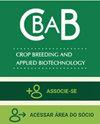高产、表型稳定的亚麻新品种CISJU21
IF 1.1
4区 农林科学
Q2 Agricultural and Biological Sciences
引用次数: 0
摘要
: UNIJUÍ作物育种项目选育的亚麻品种CISJU21,在试验条件下,是对开花早、周期短、蒴果直径大、质量优化、单株粒数高的品种进行筛选的结果,具有较高的产量稳定性和籽粒产量本文章由计算机程序翻译,如有差异,请以英文原文为准。
CISJU21 - New flax cultivar with yield and phenotypic stability
: The flax cultivar CISJU21, developed by the crop breeding program of the UNIJUÍ, was the result of selection for plants with early flowering, a shorter cycle, greater capsule diameter, optimized weight and higher number of grains per plant, with high yield stability and grain yield in the tested scenarios
求助全文
通过发布文献求助,成功后即可免费获取论文全文。
去求助
来源期刊
CiteScore
2.40
自引率
13.30%
发文量
25
审稿时长
6-12 weeks
期刊介绍:
The CBAB – CROP BREEDING AND APPLIED BIOTECHNOLOGY (ISSN 1984-7033) – is the official quarterly journal of the Brazilian Society of Plant Breeding, abbreviated CROP BREED APPL BIOTECHNOL.
It publishes original scientific articles, which contribute to the scientific and technological development of plant breeding and agriculture. Articles should be to do with basic and applied research on improvement of perennial and annual plants, within the fields of genetics, conservation of germplasm, biotechnology, genomics, cytogenetics, experimental statistics, seeds, food quality, biotic and abiotic stress, and correlated areas. The article must be unpublished. Simultaneous submitting to another periodical is ruled out. Authors are held solely responsible for the opinions and ideas expressed, which do not necessarily reflect the view of the Editorial board. However, the Editorial board reserves the right to suggest or ask for any modifications required. The journal adopts the Ithenticate software for identification of plagiarism. Complete or partial reproduction of articles is permitted, provided the source is cited. All content of the journal, except where identified, is licensed under a Creative Commons attribution-type BY. All articles are published free of charge. This is an open access journal.

 求助内容:
求助内容: 应助结果提醒方式:
应助结果提醒方式:


